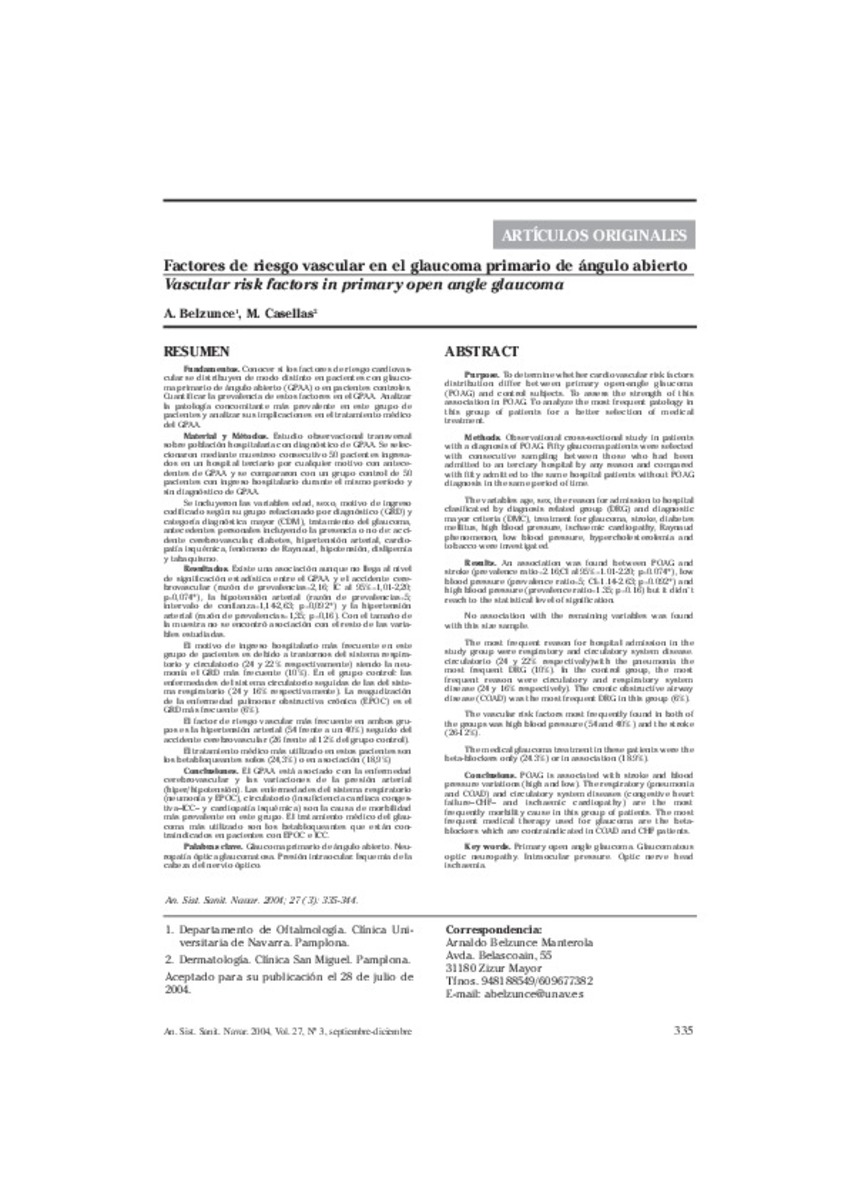Full metadata record
| DC Field | Value | Language |
|---|---|---|
| dc.creator | Belzunce, A. (Arnaldo) | - |
| dc.creator | Casellas, M. (M.) | - |
| dc.date.accessioned | 2012-12-20T11:46:29Z | - |
| dc.date.available | 2012-12-20T11:46:29Z | - |
| dc.date.issued | 2004 | - |
| dc.identifier.citation | Belzunce A, Casellas M. Factortes de riesgo vascular en el glaucoma primario de angulo abierto. An Sist Sanit Navar. 2004 Sep-Dec;27(3):335-44. | es_ES |
| dc.identifier.issn | 1137-6627 | - |
| dc.identifier.uri | https://hdl.handle.net/10171/27515 | - |
| dc.description.abstract | To determine whether cardiovascular risk factors distribution differ between primary open-angle glaucoma (POAG) and control subjects. To assess the strength of this association in POAG. To analyze the most frequent pathology in this group of patients for a better selection of medical treatment. METHODS: Observational cross-sectional study in patients with a diagnosis of POAG. Fifty glaucoma patients were selected with consecutive sampling between those who had been admitted to an tertiary hospital by any reason and compared with fifty admitted to the same hospital patients without POAG diagnosis in the same period of time. The variables age, sex, the reason for admission to hospital classified by diagnosis related group (DRG) and diagnostic mayor criteria (DMC), treatment for glaucoma, stroke, diabetes mellitus, high blood pressure, ischaemic cardiopathy, Raynaud phenomenon, low blood pressure, hypercholesterolemia and tobacco were investigated. RESULTS: An association was found between POAG and stroke (prevalence ratio=2.16;CI al 95%=1.01-2.20; p=0.074*), low blood pressure (prevalence ratio=5; CI=1.14-2.63; p=0.092*) and high blood pressure (prevalence ratio=1.35; p=0.16) but it didn't reach to the statistical level of signification. No association with the remaining variables was found with this size sample. The most frequent reason for hospital admission in the study group were respiratory and circulatory system disease. Circulatory (24 y 22% respectively)with the pneumonia the most frequent DRG (10%). In the control group, the most frequent reason were circulatory and respiratory system disease (24 y 16% respectively). The chronic obstructive airway disease (COAD) was the most frequent DRG in this group (6%). The vascular risk factors most frequently found in both of the groups was high blood pressure (54 and 40% ) and the stroke (26-12%). The medical glaucoma treatment in these patients were the beta-blockers only (24.3%) or in association (18.9%). CONCLUSIONS: POAG is associated with stroke and blood pressure variations (high and low). The respiratory (pneumonia and COAD) and circulatory system diseases (congestive heart failure-CHF- and ischaemic cardiopathy) are the most frequently mortality cause in this group of patients. The most frequent medical therapy used for glaucoma are the beta-blockers which are contraindicated in COAD and CHF patients. | es_ES |
| dc.language.iso | spa | es_ES |
| dc.publisher | Gobierno de Navarra. Departamento de Salud | es_ES |
| dc.rights | info:eu-repo/semantics/openAccess | es_ES |
| dc.subject | Vascular Diseases/complications | es_ES |
| dc.subject | Glaucoma, Open-Angle/etiology | es_ES |
| dc.title | Vascular risk factors in primary open angle glaucoma | es_ES |
| dc.title.alternative | Vascular risk factors in primary open angle glaucoma | es_ES |
| dc.type | info:eu-repo/semantics/article | es_ES |
| dc.relation.publisherversion | http://scielo.isciii.es/pdf/asisna/v27n3/orig3.pdf | es_ES |
| dc.type.driver | info:eu-repo/semantics/article | es_ES |
Files in This Item:
Statistics and impact
Items in Dadun are protected by copyright, with all rights reserved, unless otherwise indicated.






